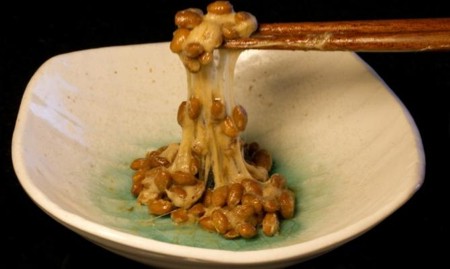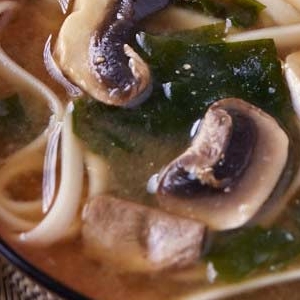There’s something mystical – even magical – about all things Japanese. Perhaps that’s because this land of fairy-tale pagodas and foods you’ve never heard of before was cut off from the rest of civilization for so long before the late 1800s, when western traders started visiting regularly…
 Natto: Fermented Beans. you either love them or hate
Natto: Fermented Beans. you either love them or hate
them… But in Japan, they’re everywhere.
Japan’s isolation from the rest of Asia – self-imposed, for the most part – certainly explains the uniqueness of its foods and preparation styles. But, now that folks from all over are becoming more and more curious about Asian foods in general and the mysteries of Japanese cuisine in particular, the tiny jewel box-like nation is yielding up its culinary secrets too all who choose to do a little exploring.
Fortunately, we have the Internet
Before the Internet came along, in the mid-1990s, all the vast majority of us had to go on about Japan – and other exotic foreign lands – was what we read in books and (occasionally) saw in the movies and on TV. A few select styles of Japanese cooking became familiar to westerners by name, if not by first-hand experience.
Now, enterprising folks are feeding not only our bellies but our minds by bringing the delicious bounty of Jpanese cooking to us. One of these is the Japan Centre ‘Japanese Food Hall’ in London, UK, a major importer and promoter of Japanese foods and customs with what might be the largest online Japanese Food website on the web.
My go-to reference
The Japan Centre website is my go-to source for information on Japanese foods and cooking styles. Their site offers at least as many pages of information on Japanese cooking – notably, authentic recipes – as it has pages in its online catalogue, and we’re going to steal a little of its Asian wisdom on the former today.
I’ve selected some dishes that might be familiar – at least in name – to some of you, to get our expedition to Japan started…
Our menu for today…
The following are selections from the Japan Centre master web page on cooking styles and key ingredients:
Sushi is one of the first foods that spring to mind when we think about Japanese cuisine. This delicacy was one of the first Japanese dishes to be exported to the US after the Meiji Restoration in 1868, and since then its popularity has steadily increased year after year. The word ‘sushi’ refers to any dish made with Japanese rice that has been seasoned with rice vinegar. Common varieties of sushi include makizushi (sushi rice and fillings rolled up in nori seaweed), nigiri sushi (shaped, bite-size mounds of sushi rice with single slices of raw fish or similar draped over the top) and inarizushi (sushi rice stuffed inside pockets of inari; a type of seasoned, fried tofu).
Udon noodles are one of the three main noodle varieties eaten in Japan. are thick, chewy, and traditionally made from wheat flour and brine water. Udon can be served in a number of different ways (mixed into stir fries, added to hot pots, served cold with a tsuyu or tentsuyu soup base on the side for dipping), but are most commonly used in noodle soups, where they are served in a savoury soup broth with different garnishes (see photo, top of page). Some of the most common udon noodle soup dishes include kitsune udon (‘fox udon’, topped with aburaage fried tofu), tempura udon (topped with tempura battered seafood and vegetables), and chikara udon (‘power udon’, topped with grilled mochi rice cakes).
Ramen is a noodle soup dish consisting of wheat noodles (also known as ‘ramen noodles’), a savoury broth (soy sauce, salt, miso, and tonkotsu pork bone are the four main ramen broth bases) and toppings of meat, protein, and/or vegetables such as sliced pork, nori seaweed, spring onions, bamboo shoots, and others. Ramen is one of present-day Japan’s absolute favourite delicacies, costing very little and being widely available in restaurants and ramen bars (which are on almost every street corner). Indeed, Japanese ramen is so popular that there is a ramen-themed museum/amusement park in Tokyo.
Soba: Otherwise known as ‘buckwheat noodles’ (‘soba’ is the Japanese word for ‘buckwheat’), soba are one of the three main varieties of noodle most frequently eaten in Japan. Unlike udon and ramen; soba noodles are made partially, if not entirely, from buckwheat flour. This gives them a distinctly earthy and slightly nutty flavour that works well with stronger flavours like garlic and sesame. Soba can be served hot in soups with toppings of spring onions, agetama tempura flakes, kamaboko fish cakes and/or grilled mochi), or cold with a side of tsuyu and garnishes of green onions, shredded nori seaweed, and wasabi.
Gyoza are savoury moon-shaped dumplings (very similar to Chinese Dim Sum Dumplings), made from a minced mixture of savoury fillings (pork mince, cabbage, green onion and mushroom is a common combination, but other fillings can be used as well) which are wrapped up in a circular gyoza wrapper and crimped or pleated around the edges to make an iconic half-moon shape. Gyoza dumplings are normally cooked by frying on one side (a process that gives the gyoza a crisp, savoury bottom), and then steaming for 2-3 minutes so that the rest of the rest of the wrapper is smooth and silky, and the filling inside is moist and juicy.
Japanese Curry (Rice): Known in Japanese as kare or kare raisu, Japanese Curry is a yoshoku dish that was originally introduced to the Japanese by the British during the Meiji era (1868-1912).Japanese curry differs from the Indian varieties with which the UK is more familiar, in that it is generally sweeter in flavour, thicker in texture, and prepared more like a stew (with meat and vegetables being cooked by boiling in water together). Japanese curry is often prepared in Japanese homes with the help of curry roux; blocks of solidified Japanese curry paste that melt into the ‘stew’ and thicken up to become a flavoursome curry sauce.
Oden: No cold Japanese winter would be complete without Oden. This winter hot pot dish, or nabemono, is made by taking an assortment of vegetables and proteins (including processed fish cakes, mochi rice cakes, boiled eggs, daikon radish, konjac yam and tofu), and stewing them in a light broth seasoned with soy sauce and dashi (a soup stock made from infusions of bonito fish flakes, kombu kelp seaweed, and/or other savoury ingredients) in a large hot pot at the centre of a table. Diners can then scoop out their favourite pieces and enjoy with karashi mustard and other condiments. As well as being a hearty main meal, the simmering hot pot also serves as a communal heater on cold evenings.
Sukiyaki: Like Oden, Sukiyaki is a Japanese nabemono hot pot dish most commonly enjoyed during the winter. Sukiyaki hot pots are prepared by searing beef slices in the hot pot, then adding sukiyaki broth (normally made from soy sauce, sake, mirin rice wine and sugar) and different vegetables, noodles, and proteins. The name ‘sukiyaki’ means ‘cook what you like’, and the joy of sukiyaki comes from being able to prepare the dish with your fellow diners, at the table, using whatever ingredients you desire.
Natto: In the same way that Marmite divides the British nation (you either love it or hate it), so too does natto divide the Japanese. This traditional Japanese food is made by fermenting soy beans in a special type of bacteria that is naturally produced in the human gastrointestinal tract. Natto has a strong smell similar to mouldy cheese, as well as a sticky/slimy texture that many find off-putting. (See photo, above.) However, many other people love these fermented soy beans for their full-bodied salty and savoury (or umami) flavour and their ample nutritional value. Is natto delicious or disgusting? It is up to you to decide.
Edamame: While frequent pub-goers in the UK like to snack on peanuts and pork scratchings with their lagers, the regulars in Japan’s izakaya pubs enjoy freshly prepared edamame. In fact, Edamame is enjoyed across eastern Asia as a snack’ sedrved in circumstances under which we might serve Salted Nuts, Pretzels or Potato Chips. These bright green, immature soy beans, harvested before the beans have hardened, are normally served in the pod after being blanched and lightly salted. As well as boasting a naturally delicious and mellow umami flavour that works beautifully with light salt seasonings, edamame beans also carry a number of health benefits (being naturally high in protein, iron, and calcium). Edamame are often served in pubs and restaurants as a complimentary appetiser.
And that’s just the start…
Tomorrow, we’ll look at some styles of Japanese cuisine that most of us have never heard about before, but which are every-day delights in the tiny, perfect island nation.
Thanks, again, to the Japanese Centre for the information and the inspiration!
~ Maggie J.

